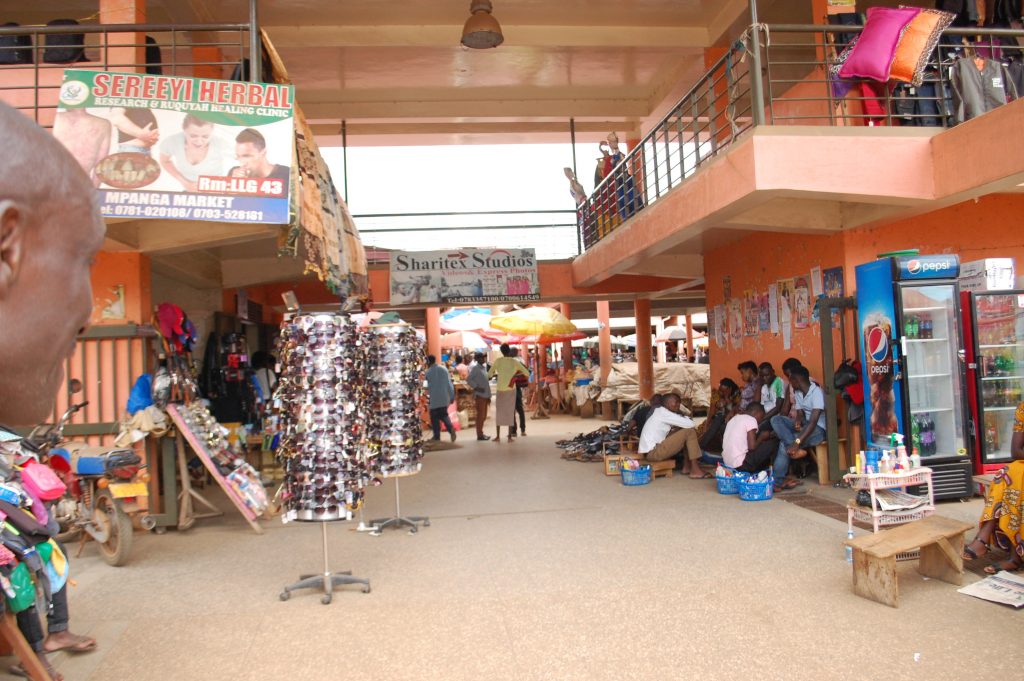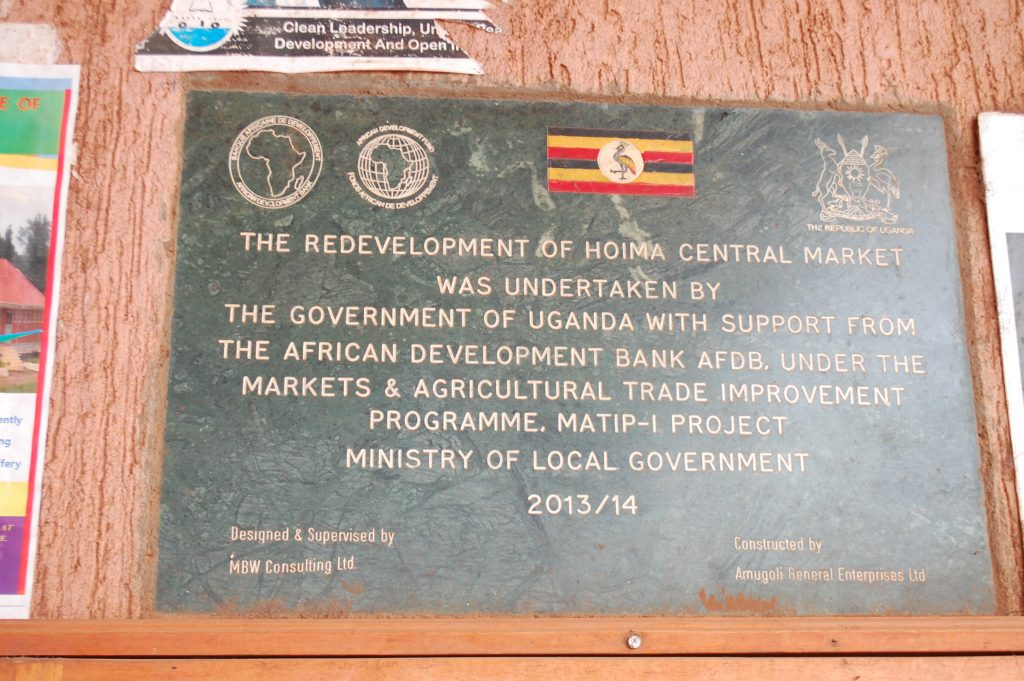
BY INNOCENT KIIZA
Ivan Bisereko, the market master of Hoima Central Market, told TheInsider.Ug that the old market started in the 1990s and later expanded in numbers to reach 300 vendors.
Renovation of the market into a modern facility under the first phase of the Markets and Agricultural Trade Improvement Project (MATIP – I) faced delays at the start due to resistance from vendors and political interference; it took a whole year before vendors could accept to be relocated to Boma grounds.
In the relocation process, according to Bisereko, Hoima municipal council only provided the space and leveled the ground for vendors to construct their temporary stalls and lockups, in addition to the lighting and water systems.
He said no compensation was given out since the relocated market was on government land
Deputy market master Wycliffe Musinguzi, who also coordinates business between municipal council and vendors, said the project cost Shs 11.624 billion and currently hosts 536 entrepreneurs (314 females and 222 males).
There are 80 youths and 10 persons with disabilities.
He said this is a reduction of numbers from the 1,000 that entered the market when it was commissioned in 2014. Numbers gradually reduced due to traders’ complaints about lack of customers.
The traders have now resorted to selling their merchandise on streets and in other smaller markets in Hoima, leaving the facility with a lot of unoccupied stalls and lockups.
He said almost half of the second floor is unoccupied and this has affected revenue collection, adding that the smaller markets are seriously outcompeting Hoima Central market.
He added that though business zoning was done, still some stalls have been boycotted by vendors on claims that their location does not bring in sufficient money.
Rent for lockups ranges from Shs 10,000 to Shs 15,000 per month but a number of vendors have defaulted on the payments, claiming they are not making money.
He added that in 2012, they would collect Shs 150 million from ground rent but due to the above challenges; currently they collect only Shs 112 million,
Which he feared may even reduce this year! Musinguzi said they have documented all the challenges after a consultative meeting with vendors on how to create more internal and external entrances to ease accessibility for the interior market.

The report and proposal were handed to the town clerk for financial assistance but no positive reaction has resulted yet.
David Kyansanku, the town clerk, said they are thinking about the vendors’ concerns but the challenge is that the contractor didn’t leave behind the market plans; so, they fear doing anything that may cause damage to the whole project.
He, however, said they have sent the proposal to the Ministry of Local Government for technical advice. Kyansaku said they have now resorted to advertising the top floor spaces as office space for potential clients like advocate firms and non-governmental organizations.
Kyansanku argued that people in Africa have a bad perception of strayed buildings, adding that it has to be changed. He was cautious about creating more entrances, saying they come with challenges of insecurity and more costs on ensuring security.
He observed that the stalls and lockups are small, which forces vendors to leave their goods outside unlocked, exposing them to thieves and rodents.
Meanwhile, Kyansanku noted that the new market has attracted new people to join business despite the various challenges. “I have seen youth in chicken business and in lockups, which was not the case in the past.
This kind of initiative has improved vendors’ livelihoods and income, if you observe the business flow around the market and shops inside,” Kyansanku added. When asked if the new market facility has reduced on the illegal markets and street hawkers, he happily said yes; adding that many mushrooming markets have been abolished and vendors encouraged relocating to the main market.
He, however, conceded that street hawkers are still a challenge but they (authorities) are looking into provisions on how to eliminate them from operating near the established entities. “You see, these young youth hawking merchandise too are looking for survival; you can’t just eliminate them from town anyhow.
You need to sit with them as an administrator and you decide on grounds they represent.” “Hawkers don’t pay trading license to council but have operational permits which allow them to operate in towns.
We are looking into how we can gazette for them spaces in the central market as a way for council to grow revenue collection.” Kyansanku mentioned the challenge of vendors in wholesale business that may be supporting hawkers because they are their main bosses and suppliers of merchandise for external income to their in-market businesses.
Responding on why there are cracks, the town clerk said some of the cracks are expansion joints, adding that such a big building has to be with joints that help it in expansion when temperature is high.
VENDORS’ OUTCRY, TESTIMONIES
Mary Nagaddya, 35, said she started wholesale business 15 years ago, but since they were relocated back in the market, business has slowed down;
She complained that business zoning was done poorly. “You see, I sell vegetables and fresh fruits on wholesale but when you move around, you will see another person selling the same items like mine and with variety; so, when will the customer reach this side to buy?” Nagaddya asked.
She suggested that authorities strictly make rules and implement the zoning very well and on business, whereby those of fruits on their section and others also on their section so that when a customer comes, he/she knows where to find what he/she is looking for rather than mixing different businesses on same section/zone.

She added that the contractors of this market did not plan for vendors in wholesale business and failed to provide a shade and stores for their products, adding that is why they have opted to be in the open space. “All the rain and sunshine fall on our products and these are fresh fruits and vegetables, which need to be preserved.
Nothing is here to help us apart from the tarpaulins and umbrellas which we buy ourselves and they get torn after time, to provide us with shade,” Nagaddya said. She mentioned that drainage channels were poorly done and have caused threat to their businesses since whenever it rains the whole water from stalls flows into their products.
Despite these challenges, Nagaddya said she has managed to take care of herself and her family of two children as a single mother.
Godfrey Tinkasiimire, a vegetable wholesaler with 17 years’ experience, said on top of operating in an open space, the taxes imposed on them are very high.
He said they are charged Shs 10,000 for offloading and they have to look for a lifter at Shs 2,000 to Shs 5,000, plus Shs 20,000 for the monthly ground rent to the council; all these eat up their would-be profits.
Tinkasiimire said if the market had provision where trucks could come inside and park for easy offloading, they could be making good profits as it was in the past old-market days.
He complained that his fellow vendors have run away from business due to high taxes and few customers, emphasizing that the main challenge affecting the business is the scattered local markets which are just a few meters away from the main market, selling the same products.
“If council could make a law to restrict all agricultural products from local markets and relocate them in the central main market here, the business here can boom and even revenue enhancement can be achieved,” Tinkasiimire said.
Market master Bisereko said such suggestions were noted and taken to the town clerk’s office, and still waiting for council resolutions.
Jovia Kusiima, 23, said she was impregnated when she was in senior four aged 16, and joined business after delivery until now.
She joined her mother who had one stall after being neglected by her husband, but she doesn’t regret. “You see, at first it’s not easy to cooperate with old women in the market and even your fellow youth look at the market as a business for old people but I easily adapted to the situation because I knew what I wanted and I am progressing now,” Kusiima said.
“I can now take care of my child and pay rent where I sleep and do saving in our Sacco.”
She mentioned that her stock is limited due to the small size of her allocated space, and this has hindered her expansion since most of the spaces near the main gate are taken.
Kusiima, whose business is operating at Shs 400,000, and hopes to expand it when she gets a loan from her Sacco, said on a good day she makes Shs 250,000 and a bad day brings in Shs 70,000 to Shs 100,000.
She feels lucky being located at near the main gate. John Muhindo, 26, a fishmonger, says his main challenges are the cold room zone which was not well planned and the breakdown of the water system in the rooms where they operate.
“We invest a lot in buying ice cubes whenever we want to preserve remained stock. So, you find that the little profits you could have moved with home, you use them to buy cubes,”Muhindo said.
Muhindo decried the rent rates as being high; a single room is at Shs 80,000 per month. He suggested that could be reduced to Shs 30,000, which is affordable.
“Fishmongers in outside markets don’t pay ground rent; they only pay dues at the gate. They make more sales than us yet we pay rent and operational license.”
He added that as fishmongers, they have established a Sacco as one way to boost their operations. He, however, requested government to help them with soft loans.
Dalison Balikagira, 59, a businesswoman with 30 years in retail business, said the number of customers that come to the market is low due to poor zoning and poor planning of the structure.
She noted that the older market had a provision where trucks could offload from within the market and this could make their work easy as they offload their stock direct to their rooms or stalls.
“We almost spend all the little profits we make on offloading and lifting the stock up to our operational rooms, and then ground rent of Shs 100,000 per month, plus Shs 60,000 for licence,” Balikagira said.
She said the market plan could be good but the leadership and constructors didn’t consult the vendors yet the structure belongs to them, adding that this has created a number of gaps which are irking business operations.
All that not withstanding, she says, in her 30 years of doing business in this market, she has educated her five children up to university level and all of them are working.
She has also bought plots and built there rentals and a small residential where she lives happily.




























